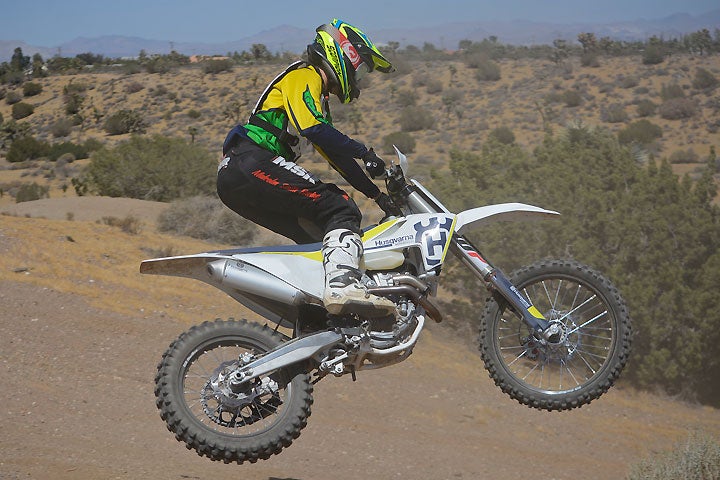
The 2017 Husqvarna FX 350 is a reflection of the fact that Husqvarna may have created its fortune in Europe for being a manufacturer of World Championship-winning motocross bikes, but in America the brand is most legendary for its exploits in the deserts of the Southwest, in the woods of the East, and in Baja California, Mexico.
That legend began in the late 1960s and early 1970s, with talented riders such as Malcolm Smith, JN Roberts and Dick Burleson piloting Husqvarna’s to win after win. American motorcycle customers took notice and flocked to Husqvarna dealers, effectively making Husqvarna an off-road racing. Of course, Husqvarna took the ball and ran with it, hiring even more top riders such as Dan Smith and Terry Cunningham, and racking up titles in Baja, the AMA National Hare & Hound Championship and the AMA National Enduro Championship. WR and OR (later XC) off-road models sold like hot cakes, making Husqvarna a best-seller in the 1970s and early 1980s.
With Husqvarna now re-established as a major player under the tutelage of KTM, it’s no surprise that its latest model line expansion focuses on off-road racing, albeit closed-course off-road racing, which is what the company states that its three new “Cross Country” models are designed for. The FX 350 is one of those models, flanked by the FX 450 and the two-stroke TX 300. Put simply, the “closed-course” designation denotes the fact that these machines are not EPA-legal for use on public land because they are not compliant with the ever-tightening (and we would argue downright ridiculous) emissions laws that govern them. They also lack U.S. Forestry-approved spark arrestors for public land use.
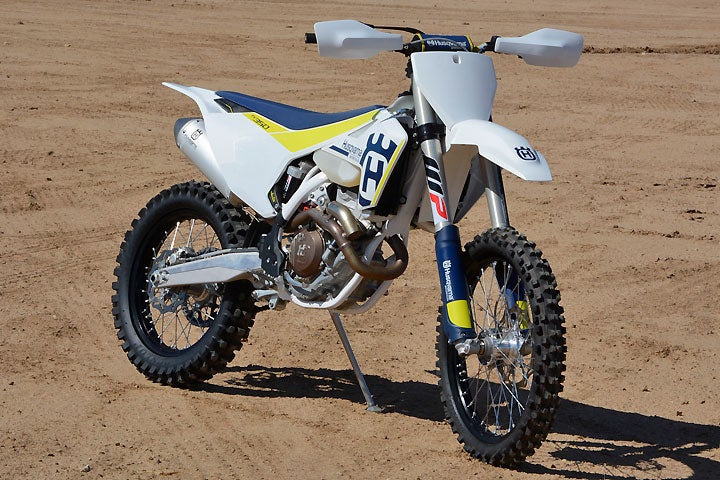
While the FX 350 is technically an all-new model for Husqvarna, it is based on its motocross counterpart, the 2017 Husqvarna FC 350, the difference being that the FX is dressed for single-track and two-track rather than the motocross track. It gets a six-speed transmission rather than the five-speed in the TC, a larger-capacity fuel tank that holds 2.2 gallons of fuel, an 18-inch rear wheel and Dunlop AT off-road tires. It also benefits from the changes made to the FC 350 for 2017.
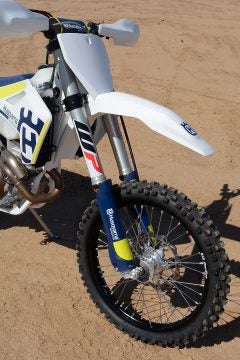
The biggest change for Husqvarna in 2017 has to do with the fork found on its competition models. Gone is the WP 4CS spring fork, and in its place is a WP AER 48 air fork that delivers 12.2 inches of travel. The AER 48 features an insulated air “spring” chamber in the left leg and a pressurized oil chamber for damping in the right. When it comes to tuning, the AER couldn’t be much simpler, as it only features one air valve located at the top of the left fork leg to fill the left chamber. The compression adjuster is located at the top of the right fork leg and the rebound adjuster is located at the bottom of the same leg. Husqvarna says that the design of the air chamber makes it impossible for air to escape, so the fork will not collapse and “fail” if a fork seal should become damaged. The AER 48 is 3.7 lbs. lighter than the 4CS it replaces. Out back, the FX 350 is suspended by a fully adjustable WP DCC piggyback shock suspended via a rising-rate linkage. Rear suspension travel is 11.8 inches.
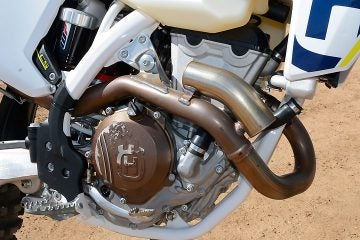
As we said, the FX 350 is based on the FC 350, which was completely revamped from the ground up for the 2016 model year, receiving an all-new engine, chassis and composite subframe. Thus, the 2017 FX 350’s liquid-cooled, DOHC, fuel-injected four-stroke Single is mechanically unchanged, featuring the same 88mm bore and 57.5 mm stroke and 14:1 compression ratio as its motocross sister, but both models sport new trickery in the form of traction-control as well as launch-control features in their multi-map Engine Management Systems. Activated via the map switch that allows the rider to adjust the ignition mapping between standard and aggressive maps to tailor the Husqvarna’s power output to suit track conditions and rider preference, the traction control can help a rider in slimy conditions. When the traction control is turned on, the EMS analyzes throttle input from the rider and the rate of increase for engine rpm and alters power accordingly to prevent excessive wheelspin.
While the Husqvarna FX 450 feeds power through a Damped Diaphragm Steel (DDS) clutch, the FX 350 transmits uses a CSS (Coil Spring Steel) and a six-speed semi-close ratio transmission that features a low-friction coating on the shifting fork for smoother and more precise shifting.
To get a feel for the 2017 Husqvarna FX 350, we tested it on motocross tracks. We tested it in the desert. We ran it over rocks and we pounded it through endless whoops over hard-packed terrain and through sand dunes. And at the end of the day we were left with distinct impressions about the FX, some of them great and some not so great.
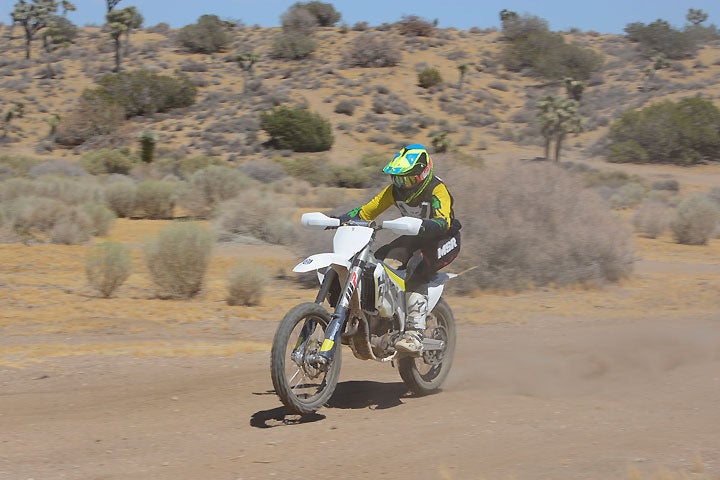
For starters, the electric-start FX 350 motor is a dream power unit. Despite its high compression ratio, the muted bark through its resonance chambered exhaust pipe and compact, FIM/AMA-compliant aluminum muffler gives no clue of the fury brewing in inside the motor, and even after spending a few hours on the FX, we were still left shaking our heads. Throttle response through its 44mm Keihin throttle body is as sharp as a knife, although the power it makes deceptive. There’s way more torque than a 250cc motor, to be sure, but the grunt is so linear that you’re not sure you’re really making any time at first. As the engine keeps pulling, you grab another gear, and another. And, before you realize what’s happening, you’re going way too fast.
The FX 350 boasts as mellifluous a power curve as any we’ve experienced. It’s practically vibration-free thanks to a multifunctional counter balance shaft that is also used to drive the water pump and timing chain and also due to the rubber-damped, CNC-machined aluminum triple clamps that are new for this year.
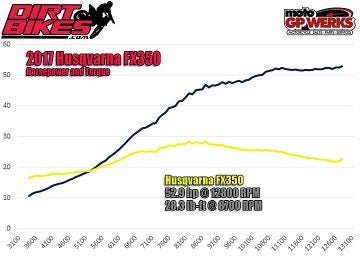
Our seat-of-the-pants intuition was at odds with the rapidly blurring scenery rushing through our goggle lens, so we looked forward to taking the FX 350 to the dyno to find out which was more trustworthy. As it turned out, the “eyes” have it. The FX pumped out a stout 52.9 rear-wheel horsepower at 12,800 rpm on Chris Redpath’s motogpwerkes.com Dynojet dyno. Frankly, we were stunned. We knew that Husqvarna claimed 58 crank hp for the 350, but we figured it to be a typo. Turns out that it’s true. Despite giving up 100cc of displacement, the Husky flat outguns the 2017 Suzuki RM-Z450 that we tested recently by two horsepower at the peak. Amazing!
Shifting through the FX six-speed transmission is as slick as creamy peanut butter, too, though we’re not big fans of the FX 350’s Magura hydraulic-activated clutch, which proved to be difficult to modulate in super-technical terrain. We found it hard to find a sweet spot that would allow us to get the FX moving from a dead stop on slick rocks without spinning up the rear wheel, and the traction control doesn’t seem to be of much help. More often than not, the FX would alternate between excessive wheelspin and stalling the engine in trials-type sections. With just a little momentum, however, the engine is as tractable as any 2017 off-road model we’ve ridden yet. Our sense of it was that the less we had to use the clutch, the better.
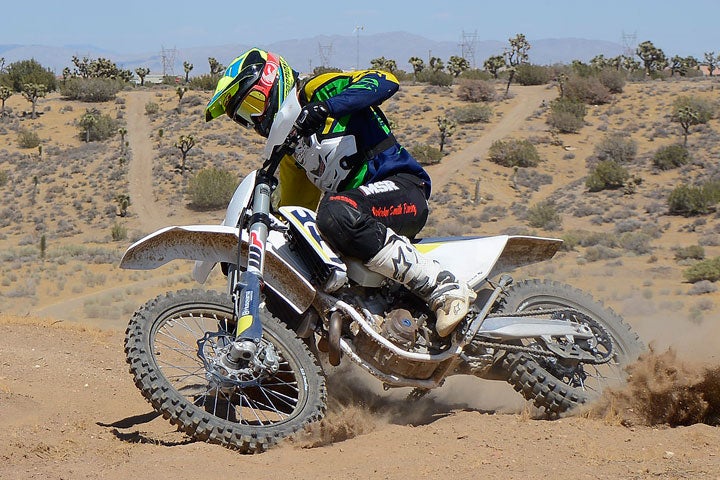
Husqvarna completely revised the FC 350’s chassis for 2016, and the 2017 FX 350 gets the same setup. The FX’s hydro-formed, laser-cut and robot-welded chrome-moly steel frame boasts 6mm wider and 2mm lower steel tubes that offer 20 percent more torsional rigidity and 30 percent less longitudinal stiffness compared to the previous generation frame design. In combination with new engine mounts, the chassis is designed to work with a 2.2-pound lighter carbon fiber subframe, making the entire chassis package lighter as well as sharper in the handling department. Another 250 grams of weight is saved by the current-generation cast-aluminum swingarm on the FX 350. With its 2.2-gallong fuel tank filled to capacity, our FX test unit weighed at 236 pounds, placing 114 pounds on the front wheel and 122 pounds on the rear wheel for a 48.3%/51.7% front/rear weight bias. Out on the track or on the trail, the FX 350 feels light as a feather, and it was no problem for our expert testers to whip the bike around in mid-air.
That said, we can only give the chassis a “decent” rating when it comes to overall handling. There’s no question that the FX 350 corners like it is on rails, requiring little more than the nod of the rider’s head to change directions. It tracks through ruts well, and its steering is neutral without being vague in fast sweepers. On the other hand, we weren’t as thrilled with it in a straight line. Its 58.5-inch wheelbase and 26.1 degree rake make for a light-steering machine, but during our prolonged high-speed desert testing we noticed that as the velocities got higher the response from the FX’s front end would become increasingly vague. It wasn’t headshake; the Husky felt stable enough. Rather, it was as if the front end was losing traction, making sudden direction changes less than confidence-inspiring.
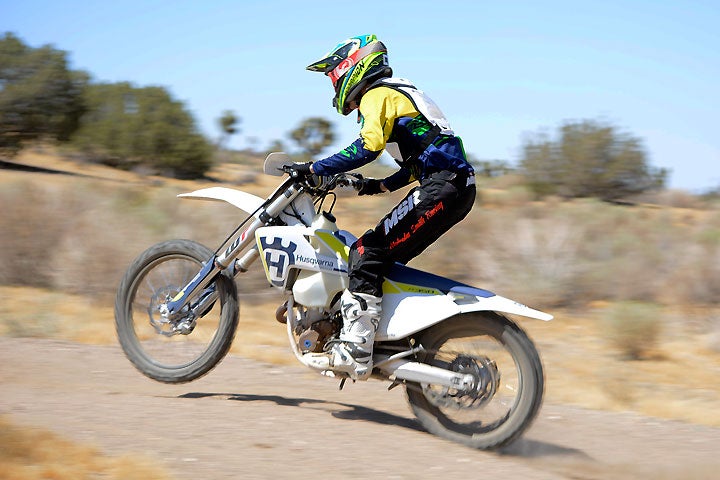
Searching for a little more front end grip, we played with the WP suspension by cranking in more preload out back and then attempting to dial in the compression and rebound before bringing the front end into balance with the rear. While we experienced some improvement, we came to realize that Husqvarna must like to valve its suspension on the soft side—something we experienced last year during our 2016 Husqvarna FC 450 with its previous-generation suspension. It’s especially true up front where the new fork is the same as the old in the sense that it soaks up small bumps and ripples with ease but it also tends to blast through the stroke too easily.
We added air to the fork and got some relief, but overall we would recommend consulting your Husqvarna dealer or a WP specialist to get help with dialing-in the fork. Despite the simplicity of the new WP AER 48 fork, dialing it in isn’t all that much easier than other air forks we’ve tested. The AER 48 is one of the best air units on the market now, but we’d still take a conventional coil spring fork any day. With regard to the FX’s handling, as one tester stated, “It just feels like the front end is too light.” Does the fact that the AER 48 is nearly 4 pounds lighter than the 4CS have anything to do with what we were feeling? Could be. A little more weight on the front of the machine certainly wouldn’t hurt.
Just as with the our FC 450, we had much less of an issue sorting out the rear suspension, although our expert test riders still felt that it was willing to bottom on big hits a little too easily. Our vet testers had no such complaints, praising the WP’s rising rate rear end for its cushy feel.
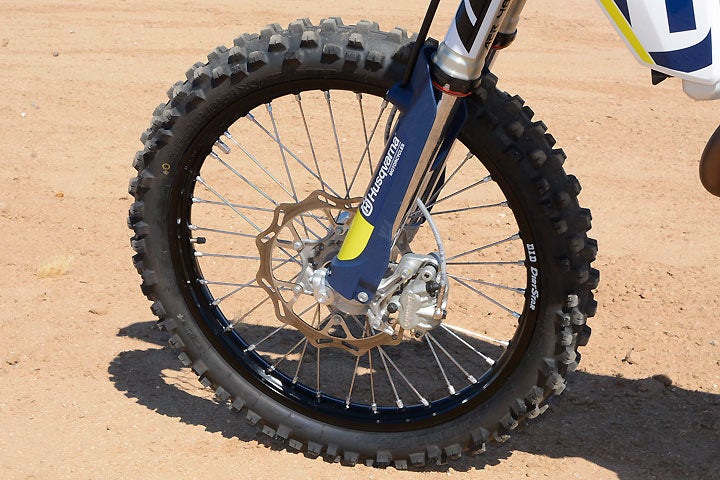
The FX 350’s brakes are without equal in our books (unless you count KTM). The Husky’s GSK 260mm front rotor and Brembo two-piston front caliper can halt the proceedings with authority like few other dirtbikes we’ve ever tested. Ditto for the rear GSK 220mm disc/single-piston Brembo combination out back. Sure, some riders might find them to be a bit grabby at first, but get used to them and you simply won’t be able to stop any quicker with anything else.
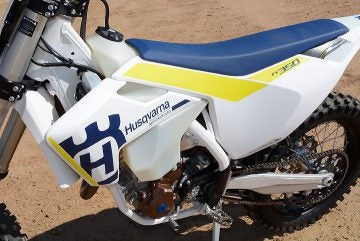
All of our testers, tall and short, praised the FX 350’s ergonomics. Its gripper seat and 1 1/8-inch Pro Taper bars helped to make for a nice comfy position whether seated or standing, and the Husqvarna’s top clamp is adjustable for anyone seeking a little different more room. The chassis also has a narrow feel through the middle, and its slim radiator shrouds eliminate the worry that a rider will snag a boot when cranked over in a turn.
Other details we noticed were good and bad. Items like the FC 350’s machined, polished hubs, Dunlop GEOMAX AT tires and ODI lock grips were nice touches, as were the off-road worthy handguards. On the other hand, the FX 350 lacks a bash plate of any kind to protect its vulnerable cases from rock and root damage.
The 2017 Husqvarna FX 350 retails for $9999, making it just a buck under a full $10K for a 350cc off-road motorcycle. That’s a premium price to pay, and there are some things that we would like to see added or improved, most notably a good bash plate and more fine tuning of the AER 48 fork. But the lure of that sweet 350cc motor would be enough to get us to open our wallets, and we know it won’t be a problem for any Husqvarna diehards out there.
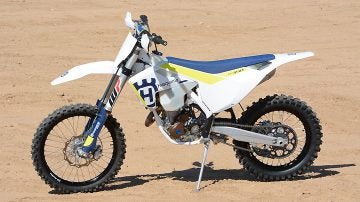 2017 Husqvarna FX 450 Specifications
2017 Husqvarna FX 450 Specifications
MSRP: $9999
Engine: Type 349.7cc liquid-cooled SOHC 4-stroke
Bore x Stroke: 88.0mm x 57.5mm
Compression Ratio: 12.6:1
Fuel Delivery: Keihin 44mm throttle body
Ignition: Keihin EMS w/adjustable engine maps, traction control/launch control
Max. Horsepower (measured): 52.9 rwhp @ 12,800 rpm
Max. Torque (measured): 28.3 lb-ft. @ 8700 rpm
Transmission: 6-speed; Magura hydraulic-activated CCS clutch
Final Drive: chain
Chassis: 25CRMo4 steel central-tube frame w/carbon-fiber subframe, aluminum swingarm
Front Suspension: 48mm WP AER 48 air/cartridge fork; fully adjustable, 12.2-in. of wheel travel
Rear Suspension: WP single shock; fully adjustable; 11.8-in. of wheel travel
Front Brake: Brembo two-piston caliper, GSK 260mm rotor
Rear Brake: Brembo single-piston caliper, GSK 200mm rotor
Front Tire: Dunlop GEOMAX AT 80/100-21
Rear Tire: Dunlop GEOMAX 120/90-19
Seat Height: 37.8 in.
Wheelbase: 58.5 in.
Rake: 26.1 degrees
Trail: n/a
Ground Clearance: 14.5 in.
Fuel Capacity: 2.2 gal.
Wet Weight (measured): 236 lbs.
Color: White/Blue/Yellow
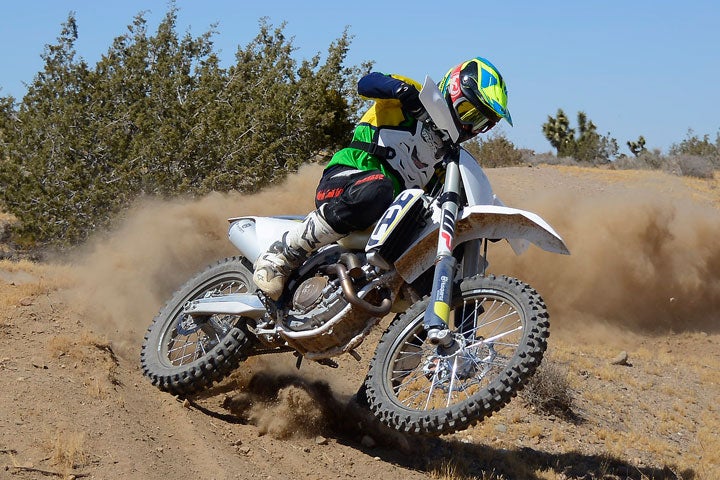


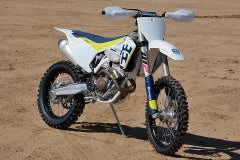

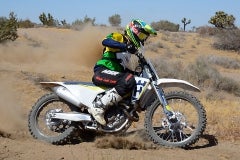


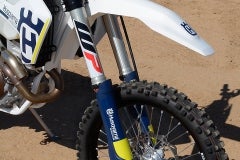
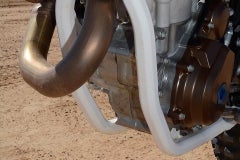
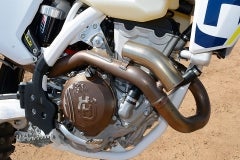
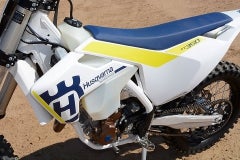
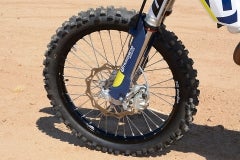
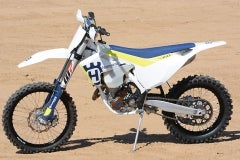
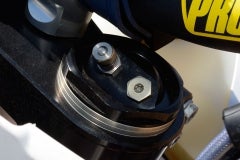
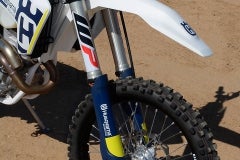
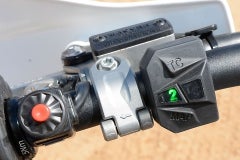
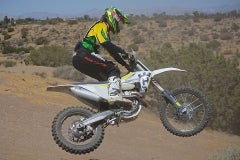

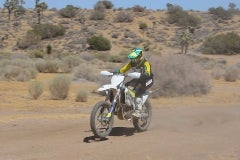
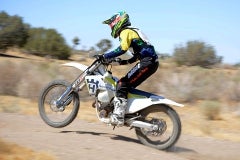



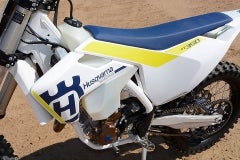
 Your Privacy Choices
Your Privacy Choices